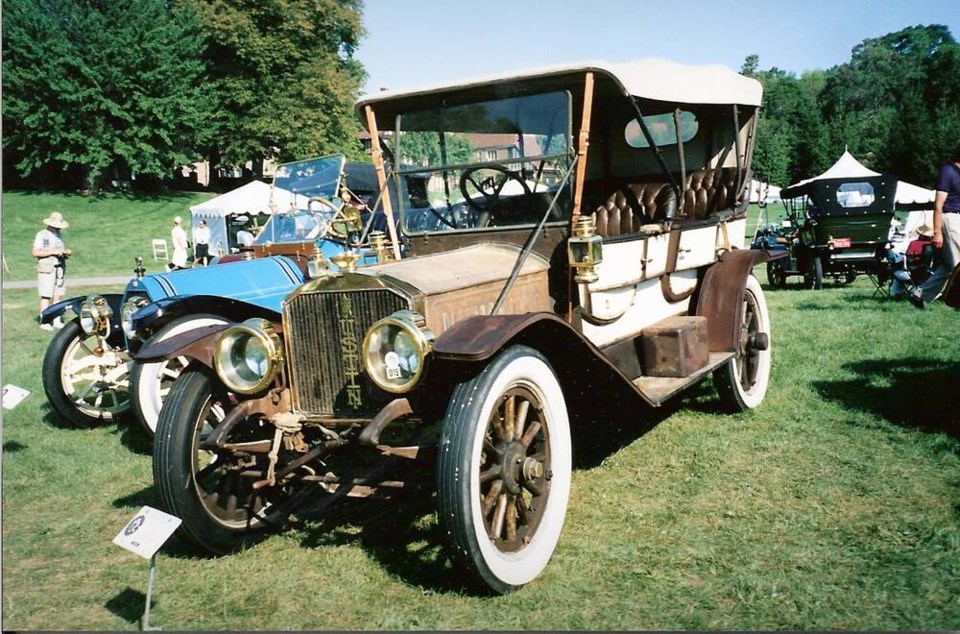Americans mostly learned of the Austin automobile name from an Americanized version of the little English Austin Seven called the American Austin/Bantam built in Butler, Pensylvania, during the 1930s and early forties. They came to know it again after the Second World War when such imported English sedans as the Austin A40 and A50 and Austin-Healey sports car began arriving.
There was, however, another Austin built in the United States besides the American Austin/Bantam. It was from the Austin Automobile Co., totally unrelated to those revised small English cars, and is barely remembered now. Designed and built in Grand Rapids, Michigan, early in the twentieth century, it was at the opposite end of the automotive spectrum from the miniature Austin/Bantam.
While Austin/Bantams were tiny cars with four cylinder engines of less than one-litre, the Grand Rapids Austins were large and luxurious. They started with two and four cylinders for the first four years, and then went to sixes and eventually 12s.
The Austin Automobile Co. idea evolved when Grand Rapids lumber dealer James E. Austin invested in the Michigan Iron Works in 1900. His mechanically talented son Walter took over the operation with the intention of developing a motor car. He set to work on his idea and had his first running prototype ready by the end of 1902.
It had a 25 horsepower two cylinder engine and was a sound enough design that Austin built and sold 13 of them in 1903. Encouraged by this success he got serious about the automobile business. For 1904 he added 35 and 50 horsepower fours and phased out the two cylinder version.
Since most customers who were buying cars in those early days of the automobile were well-to-do, Austin concentrated on the upscale market. The size of the cars was increased from a wheelbase of 2286 mm (90 in.) in 1903 to 2743 mm (108 in.) in ‘05. It would ultimately go to a very substantial 3607 mm (142 in.)
As well as increasing their size, Austin added a 90 horsepower six cylinder engine in 1907, moving it ahead of such respected marques as Cadillac, Packard, Pierce-Arrow and Peerless.
Ironically, Henry Ford, also of Michigan and the champion of light basic cars, had brought out the luxurious six cylinder Ford Model K a year earlier. It was not Henry’s preference, but built at the insistence of his financier Detroit coal merchant Alexander Malcomson. It was to appeal to people like himself in the upscale market and Ford discontinued it when he got free of Malcomson.
The progressive Austin added electric lights in 1911 and moved the steering wheel to the left side. In 1913 Austin fitted an exclusive two-speed rear axle for more relaxed highway cruising, just beating out Cadillac with this feature.
With its wheelbase now up to 3581 mm (141 in.) for between-the-axles seating, an overdrive and its big six cylinder engine, Austin confidently adopted the motto “The Highway King.”
During the First World War (1914-1918) Austin began offering a lighter, less expensive model, but believed its future still lay in big luxury cars. Thus in 1917 it went exclusively to a V-12 engine a year after Packard introduced its famous V-12 “Twin Six.” It thus jumped ahead of Cadillac and Peerless who both had V-8s. Pierce-Arrow had a six.
The big luxurious twelve cylinder model attracted such celebrity customers as newspaper publisher William Randolf Hearst and boxer Jack Johnson, the black man who defeated white James Jeffries in 1910 for the world’s heavyweight championship in “The Fight of the Century.” The win caused race riots and murders.
The end of the First World War brought an economic recession that created hardship and cutbacks in the automobile industry. Even General Motors fell into the hands of the bankers for the second time, ousting founder Billy Durant for the second and last time.
With only luxury cars and no lower priced models to fall back on Austin went out of business in 1920. Production had never been high, probably no more than 1000 cars over 18 years. Another American luxury car had passed into history.
As a small footnote, in 1930 when Austin of England was planning for American production of its tiny Austin Seven it chose Butler, Pennsylvania for its plant. When Grand Rapids officials heard this they immediately set out to have them manufactured in their town based on its historic ties to the Austin name.
Although the Grand Rapids Austin had no connection with the English Austin, Grand Rapids worked hard to entice the new company. But the Butler people would have nothing to do with this and pledged some $450,000 to keep American Austin in Butler. Unable or unwilling to stay in the game, Grand Rapids quietly bowed out of the picture.



